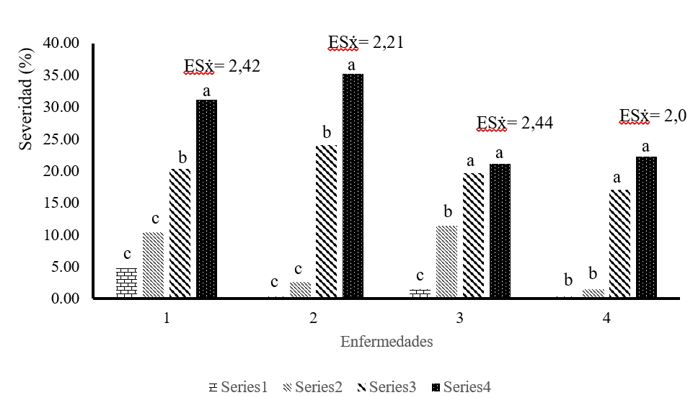Effect of population densities on diseases and the yield of Oryza sativa L.
Main Article Content
Abstract
Farmers in Cuba sow high doses of seeds to guarantee rice populations and therefore obtain better yields, however, this trend is counterproductive since production becomes more expensive due to seed costs, fertilizers, fungicides, insecticides and they are not always achieved the expected yields due to the inadequate development of plants and the high incidence of pests. Based on this problem, the objective of this work was to evaluate the interaction between four doses of cultivar LP-5 seed and the incidence and severity of fungal diseases on rice yield. For this, plots were made and sown with four doses of seeds (100, 120, 140, 160 kg ha-1). A randomized block design with five repetitions was carried out. In each of the variants, the incidence and severity of the main rice diseases were evaluated, and the theoretical yield and its components were also evaluated. Highest incidences and severity of diseases were observed when the highest doses of seeds were applied (160 and 140 kg ha-1), regardless of the disease and the evaluation time. It was found that it is not always that high planting densities lead to higher yields. As the seed dose increased, the distribution and incidence of diseases increased, fundamentally affecting the number of filled grains per panicle and the weight of one thousand grains. Highest yields were obtained at doses of 120 and 140 kg ha-1.
Article Details

This work is licensed under a Creative Commons Attribution-NonCommercial 4.0 International License.
Those authors who have publications with this journal accept the following terms of the License Attribution-NonCommercial 4.0 International (CC BY-NC 4.0):
You are free to:
- Share — copy and redistribute the material in any medium or format
- Adapt — remix, transform, and build upon the material
The licensor cannot revoke these freedoms as long as you follow the license terms.
Under the following terms:
- Attribution — You must give appropriate credit, provide a link to the license, and indicate if changes were made. You may do so in any reasonable manner, but not in any way that suggests the licensor endorses you or your use.
- NonCommercial — You may not use the material for commercial purposes.
- No additional restrictions — You may not apply legal terms or technological measures that legally restrict others from doing anything the license permits.
The journal is not responsible for the opinions and concepts expressed in the works, they are the sole responsibility of the authors. The Editor, with the assistance of the Editorial Committee, reserves the right to suggest or request advisable or necessary modifications. They are accepted to publish original scientific papers, research results of interest that have not been published or sent to another journal for the same purpose.
The mention of trademarks of equipment, instruments or specific materials is for identification purposes, and there is no promotional commitment in relation to them, neither by the authors nor by the publisher.
References
Cristo E, González MC, Pérez NJ, Evaluación de nuevos cultivares de arroz (Oryza sativa L.) en condiciones de bajos suministros de agua y fertilizantes en la provincia de Pinar del Río. Cultivos Tropicales. 2016;37(2):127-133. DOI: 10.13140/RG.2.1.4892.8240
Ortiz AE, Rodríguez V, Carrillo JR. Evaluación de dos variedades de arroz (Oryza sativa l.), durante el proceso de secado en el secadero “Emilio Lastre” Revista científico educacional de la provincia Granma. 2020;16. ISSN: 2074-0735.
Rodríguez AT, Miranda A, Cruz A, Rivero D, Cristo E, et al. El cultivo del arroz en Los Palacios. Colectivo de autores, ed. INCA. 2019. p. 129. Available from: https://isbn.cloud/9789597258018/el-cultivo-del-arroz-en-los-palacios/
Ruiz P. Eficacia de un nuevo formulado para el control de hongos en semillas de arroz. 2021;10(3):149-160, Available from: http://revistas.unica.cu/uciencia.
Arias JG, Esquivel EA, Campos R. Evaluación de la densidad de siembra y nivel de fertilización en arroz, para las variedades Palmar-18, Lazarroz FL y NayuribeB FL, en Parrita, Costa Rica. Revista Tecnología en Marcha. 2020;33(3):13.24. Available from: https://orcid.org/0000-0001-9553-060X .
Ministerio de la Agricultura. Instructivo Técnico para el cultivo del arroz. La Habana, Cuba: Ediciones Instituto de Investigaciones del Arroz; 2015.115 p.
Folgueras M, Rodríguez S, Herrera L, Sánchez S. Influencia de diferentes métodos de plantación en la incidencia de las pudriciones radicales de la yuca (Manihot esculenta Crantz). Revista Cuadernos de Fitopatología. 2011; 28:23-27.
Estándar Evaluation System for Rice (SES). International Rice Research Institute (IRRI). 2002.
Townsend GR, Heuberger JW. Methods for estimating losses caused by diseases in fungicide experiments. Plant Disease Reporter. 1943; 60: 340-343.
Cruz A, Deyanira Rivero, Danay Infante, Anayza Echevarría, Martínez B. Manejo de hongos fitopatógenos en Phaseolus vulgaris L. con la aplicación de Trichoderma asperellum Samuels, Lieckfeldt & Nirenberg. Rev. Protección Vegetal. 2018;33(3) Available from: http://opn.to/a/FxAlu.
Hernández A, Pérez JM, Bosch D, Castro N. La clasificación de suelos de Cuba: énfasis en la versión de 2015. Cultivos Tropicales, 2019;40(1): ISSN digital: 1819-4087. Available from: http://scielo.sld.cu/pdf/ctr/v40n1/1819-4087-ctr-40-01-e15.pdf
Jiménez O, Silva R, Cruz J. Efecto de densidades de siembra sobre el rendimiento en el arroz (Oryza sativa L.) en el Municipio Santa Rosalia, Estado de Portugueza Venezuela. Revista Unellez de Ciencia y Tecnología. 2009; (27):32- 41, ISSN 1012-7054.
Kakar K, Nitta Y, Asagi N, Komatsuzaki M, Shiotsu F, Kokubo T, Xuan TD. Morphological analysis on comparison of organic and chemical fertilizers on grain quality of rice at different planting densities, Plant Production Science. 2019;22(4):510-518. DOI: 10.1080/1343943X.2019.1657777.
Tian G, Gao L, Kong Y, Hu X, Xie K, Zhang R, et al. Improving rice population productivity by reducing nitrogen rate and increasing plant density. 2017;12(8). Available from: https://doi.org/10.1371/journal.pone.0182310.
Zhou C, Huang Y, Jia B, Wang Y, Wang Y, Xu Q, Li R, Wang S, Dou F. Effects of Cultivar, Nitrogen Rate, and Planting Density on Rice-Grain Quality. Agronomy. 2018;8. Available from: https://doi.org/10.3390/agronomy8110246.
Ameen A, Aslam Z, Zaman QE, Zamir S, Khan I, Subhani M. Performance of Different Cultivars in Direct Seeded Rice (Oryza sativa L.) with Various Seeding Densities. American Journal of Plant Sciences. 2014;5:3119-3128. doi: 10.4236/ajps.2014.521328.
